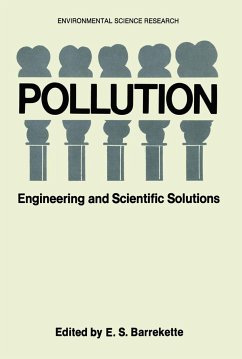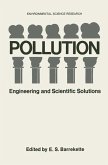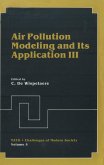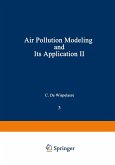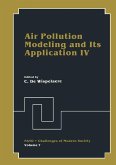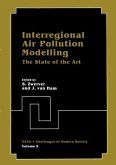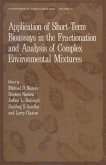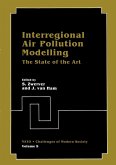- Gebundenes Buch
- Merkliste
- Auf die Merkliste
- Bewerten Bewerten
- Teilen
- Produkt teilen
- Produkterinnerung
- Produkterinnerung
The rapid deterioration of the environment in many countries around the world, or of segments and aspects of the environment in specific locations, made it necessary that immediate - even if only short term - solutions be found to as many of these problems as possible. Nevertheless, in the long run, long range and long term solutions must be found taking into account the effects of one country or region on another as well as of the inter-action between the different types of pollution over extended periods of time. It was the purpose of the Tel Aviv meeting on Pollution: Engineering and…mehr
Andere Kunden interessierten sich auch für
![Pollution Pollution]() Pollution166,99 €
Pollution166,99 €![Air Pollution Modeling and Its Application III Air Pollution Modeling and Its Application III]() C. De Wispelaere (ed.)Air Pollution Modeling and Its Application III113,99 €
C. De Wispelaere (ed.)Air Pollution Modeling and Its Application III113,99 €![Air Pollution Modeling and Its Application II Air Pollution Modeling and Its Application II]() C. De Wispelaere (ed.)Air Pollution Modeling and Its Application II113,99 €
C. De Wispelaere (ed.)Air Pollution Modeling and Its Application II113,99 €![Air Pollution Modeling and Its Applications IV Air Pollution Modeling and Its Applications IV]() C. De WisepelacreAir Pollution Modeling and Its Applications IV113,99 €
C. De WisepelacreAir Pollution Modeling and Its Applications IV113,99 €![Interregional Air Pollution Modelling Interregional Air Pollution Modelling]() S. ZwerverInterregional Air Pollution Modelling42,99 €
S. ZwerverInterregional Air Pollution Modelling42,99 €![Application of Short-Term Bioassays in the Fractionation and Analysis of Complex Environmental Mixtures Application of Short-Term Bioassays in the Fractionation and Analysis of Complex Environmental Mixtures]() Michael D. Waters (ed.)Application of Short-Term Bioassays in the Fractionation and Analysis of Complex Environmental Mixtures112,99 €
Michael D. Waters (ed.)Application of Short-Term Bioassays in the Fractionation and Analysis of Complex Environmental Mixtures112,99 €![Interregional Air Pollution Modelling Interregional Air Pollution Modelling]() S. ZwerverInterregional Air Pollution Modelling112,99 €
S. ZwerverInterregional Air Pollution Modelling112,99 €-
-
-
The rapid deterioration of the environment in many countries around the world, or of segments and aspects of the environment in specific locations, made it necessary that immediate - even if only short term - solutions be found to as many of these problems as possible. Nevertheless, in the long run, long range and long term solutions must be found taking into account the effects of one country or region on another as well as of the inter-action between the different types of pollution over extended periods of time. It was the purpose of the Tel Aviv meeting on Pollution: Engineering and Scientific Solutions, to address presently known or foreseeable "environmental insults;" that is, to focus on those aspects of air, noise, land, water or any other environmental quality for which there already exist engineering, scientific, legal or other solutions. Consequently, people from all disci plines which are relevant to environmental problems and their solutions were invited to participate.
Hinweis: Dieser Artikel kann nur an eine deutsche Lieferadresse ausgeliefert werden.
Hinweis: Dieser Artikel kann nur an eine deutsche Lieferadresse ausgeliefert werden.
Produktdetails
- Produktdetails
- Environmental Science Research 2
- Verlag: Springer / Springer US / Springer, Berlin
- Artikelnr. des Verlages: 978-0-306-36302-3
- 1973.
- Seitenzahl: 784
- Erscheinungstermin: 1. Februar 1973
- Englisch
- Abmessung: 244mm x 170mm x 43mm
- Gewicht: 1297g
- ISBN-13: 9780306363023
- ISBN-10: 030636302X
- Artikelnr.: 23073258
- Herstellerkennzeichnung
- Libri GmbH
- Europaallee 1
- 36244 Bad Hersfeld
- gpsr@libri.de
- Environmental Science Research 2
- Verlag: Springer / Springer US / Springer, Berlin
- Artikelnr. des Verlages: 978-0-306-36302-3
- 1973.
- Seitenzahl: 784
- Erscheinungstermin: 1. Februar 1973
- Englisch
- Abmessung: 244mm x 170mm x 43mm
- Gewicht: 1297g
- ISBN-13: 9780306363023
- ISBN-10: 030636302X
- Artikelnr.: 23073258
- Herstellerkennzeichnung
- Libri GmbH
- Europaallee 1
- 36244 Bad Hersfeld
- gpsr@libri.de
1. Climatic Aspects of Pollution.- 1.1 Global Effects of Contaminants in the Upper Atmosphere.- 1.2 Climatic Aspects of Waste Heat.- 1.3 Cooling Towers and Weather Modification.- 2. Pollution and Space.- 2.1 Man-Made Alterations of the Near Earth Space Environment.- 2.2 Orbital Pollution Control.- 2.3 Global Air Pollution Monitoring from Satellites: Prospects and Problems.- 2.4 Environmental Observations from Space - The Promise and the Challenge.- 3. Air Pollution.- 3.1 A Model for Fluid Mechanical Studies of Air Pollution.- 3.2 A Systematic Method for Evaluating the Potential Environmental Impact of New Industrial Chemicals.- 3.3 Effect of Additives on Boiler Cleanliness and Particulate Emissions.- 3.4 High Temperature Dust Control - Application of a Combination Particle Collector and Heat Exchanger.- 4. Agricultural and Pest Control Aspects of Pollution.- 4.1 Solutions to Problems of Soil Pollution by Agricultural Chemicals.- 4.2 Control of Air Pollution Affecting or Caused by Agriculture.- 4.3 The Creation and Control of Pest Situations Through Engineering: Past, Present and Future.- 4.4 The Neo-Technological Landscape Degradation and Its Ecological Restoration.- 4.5 Some Aspects of the Role of Engineering in the Competition Between Insects and Man.- 5. Sulfur Dioxide.- 5.1 Sulfur Dioxide Removal from Gases, U. S.: Lime-Limestone.- 5.2 Special Problems of the Smelter Industry.- 5.3 Sulfur Dioxide Removal from Waste Gases: A Status Report from United States: Recovery Processes.- 5.4 Sulphur Dioxide Removal from Waste Gases: A Status Report from Japan.- 5.5 Sulfur Dioxide Removal from Waste Gases: A Status Report - Europe.- 6. Propellants and Explosives.- 6.1 Pollution Abatement in the Manufacture and Loading of Propellants and Explosives.- 6.2 InvestigationsRelated to Prevention and Control of Water Pollution in the U. S. TNT Industry.- 6.3 Control of Nitrogen Oxide Emissions for Nitric Acid Plants.- 6.4 Abatement of Nitrobodies in Aqueous Effluents from TNT Production and Finishing Plants.- 6.5 Explosive Incineration.- 6.6 The U. S. Navy PEPPARD Program.- 6.7 Elimination of Styphnic Acid from Plant Effluents.- 7. Solid Waste, Land Use.- 7.1 Environmental Problems and Solutions Associated with the Development of the World's Largest Lead Mining District.- 7.2 A Study of the Effectiveness of Backfilling in Controlling Mine Drainage.- 7.3 Land Disposal of Septage (Septic Tank Pumpings).- 7.4 Resource Recovery from Municipal Waste - A Review and Analysis of Existing and Emerging Technology.- 7.5 Removal of Trace Metals from Wastewater by Lime and Ozonation.- 7.6 A Floating Settler for Low Cost Clarification.- 8. Sensing, Instrumentation, and Measurement.- 8.1 Measurement and Collaborative Testing for Implementation of Air Quality.- 8.2 The Use of Airborne Sensor Systems for Environmental Monitoring.- 8.3 Radio Wave Monitoring of the Depth and Salinity of the Water Table.- 8.4 Remote Measurement of Air Pollutants Utilizing the Raman Effect.- 8.5 Remote Sensing of Pollutants by Means of Stereo Analysis.- 8.6 Profiles of the Natural Contaminant Radon 222 as a Measure of Vertical Diffusivity.- 8.7 Spectrophotometric Determination of Indole and Skatole Using Lignine Extractions.- 9. Models.- 9.1 The Steady-State Demand-Output-Waste Economy.- 9.2 Simulation of Populations, with Particular Reference to the Grain Beetle, Tribolium.- 9.3 Pollution by Diffusive Processes.- 9.4 Computer Control of Physical-Chemical Wastewater Treatment.- 9.5 Computation and Mapping of the Dispersion and Herbage Uptake of Gaseous Effluents fromIndustrial Plants.- 9.6 Particle Deposition and Diffusivities along Smooth Surfaces.- 10. Noise.- 10.1 Industrial Noise Pollution.- 10.2 Motor Vehicle Noise.- 10.3 Engineering and Scientific Implications of Noise Control Legislation.- 10.4 Noise Pollution in Developing Countries and in Israel in Particular.- 11. National and Local Problems and Solutions.- 11.1 Environmental Protection in the U. S..- 11.2 Pollution Problems in Australia - A Large, Sparsely Populated, Rapidly Developing Country.- 11.3 The Canadian Pollution Problem - A Need for Broader Perceptions.- 11.4 A Cooperative Approach to Pollution Problems in Canada.- 11.5 Some Pollution Problems in Nigeria.- 11.6 Legal Control of Industrial Air Pollution in Israel.- 11.7 Air Pollution Trends in Tel Aviv, Israel.- 11.8 A Dual-Purpose Air Pollution Alert and Implementation System for the Greater Tel-Aviv Area.- 12. Political, Social, Educational, and Industrial Aspects of Pollution.- 12.1 Politics and Pollution: Political Solutions to a Deteriorating Environment.- 12.2 Some Economic, Spatial, Social, and Political Indicators of Environmental Quality of Urban Life.- 12.3 Teratological Hazards due to Phenoxy Herbicides and Dioxin Contaminants.- 12.4 Strategy for Maintaining Environmental Quality in Developing Technological Societies.- 12.5 Environment's Most Dangerous Pest: Man.- 12.6 Environmental Education as a Means of Creating an Awareness of Pollution by Tomorrow's Youth.- 12.7 Pollution and Public Information.- 12.8 Are Industry and Government Fulfilling Their Responsibilities for Pollution Control?.- 12.9 Industrial Zoning.
1. Climatic Aspects of Pollution.- 1.1 Global Effects of Contaminants in the Upper Atmosphere.- 1.2 Climatic Aspects of Waste Heat.- 1.3 Cooling Towers and Weather Modification.- 2. Pollution and Space.- 2.1 Man-Made Alterations of the Near Earth Space Environment.- 2.2 Orbital Pollution Control.- 2.3 Global Air Pollution Monitoring from Satellites: Prospects and Problems.- 2.4 Environmental Observations from Space - The Promise and the Challenge.- 3. Air Pollution.- 3.1 A Model for Fluid Mechanical Studies of Air Pollution.- 3.2 A Systematic Method for Evaluating the Potential Environmental Impact of New Industrial Chemicals.- 3.3 Effect of Additives on Boiler Cleanliness and Particulate Emissions.- 3.4 High Temperature Dust Control - Application of a Combination Particle Collector and Heat Exchanger.- 4. Agricultural and Pest Control Aspects of Pollution.- 4.1 Solutions to Problems of Soil Pollution by Agricultural Chemicals.- 4.2 Control of Air Pollution Affecting or Caused by Agriculture.- 4.3 The Creation and Control of Pest Situations Through Engineering: Past, Present and Future.- 4.4 The Neo-Technological Landscape Degradation and Its Ecological Restoration.- 4.5 Some Aspects of the Role of Engineering in the Competition Between Insects and Man.- 5. Sulfur Dioxide.- 5.1 Sulfur Dioxide Removal from Gases, U. S.: Lime-Limestone.- 5.2 Special Problems of the Smelter Industry.- 5.3 Sulfur Dioxide Removal from Waste Gases: A Status Report from United States: Recovery Processes.- 5.4 Sulphur Dioxide Removal from Waste Gases: A Status Report from Japan.- 5.5 Sulfur Dioxide Removal from Waste Gases: A Status Report - Europe.- 6. Propellants and Explosives.- 6.1 Pollution Abatement in the Manufacture and Loading of Propellants and Explosives.- 6.2 InvestigationsRelated to Prevention and Control of Water Pollution in the U. S. TNT Industry.- 6.3 Control of Nitrogen Oxide Emissions for Nitric Acid Plants.- 6.4 Abatement of Nitrobodies in Aqueous Effluents from TNT Production and Finishing Plants.- 6.5 Explosive Incineration.- 6.6 The U. S. Navy PEPPARD Program.- 6.7 Elimination of Styphnic Acid from Plant Effluents.- 7. Solid Waste, Land Use.- 7.1 Environmental Problems and Solutions Associated with the Development of the World's Largest Lead Mining District.- 7.2 A Study of the Effectiveness of Backfilling in Controlling Mine Drainage.- 7.3 Land Disposal of Septage (Septic Tank Pumpings).- 7.4 Resource Recovery from Municipal Waste - A Review and Analysis of Existing and Emerging Technology.- 7.5 Removal of Trace Metals from Wastewater by Lime and Ozonation.- 7.6 A Floating Settler for Low Cost Clarification.- 8. Sensing, Instrumentation, and Measurement.- 8.1 Measurement and Collaborative Testing for Implementation of Air Quality.- 8.2 The Use of Airborne Sensor Systems for Environmental Monitoring.- 8.3 Radio Wave Monitoring of the Depth and Salinity of the Water Table.- 8.4 Remote Measurement of Air Pollutants Utilizing the Raman Effect.- 8.5 Remote Sensing of Pollutants by Means of Stereo Analysis.- 8.6 Profiles of the Natural Contaminant Radon 222 as a Measure of Vertical Diffusivity.- 8.7 Spectrophotometric Determination of Indole and Skatole Using Lignine Extractions.- 9. Models.- 9.1 The Steady-State Demand-Output-Waste Economy.- 9.2 Simulation of Populations, with Particular Reference to the Grain Beetle, Tribolium.- 9.3 Pollution by Diffusive Processes.- 9.4 Computer Control of Physical-Chemical Wastewater Treatment.- 9.5 Computation and Mapping of the Dispersion and Herbage Uptake of Gaseous Effluents fromIndustrial Plants.- 9.6 Particle Deposition and Diffusivities along Smooth Surfaces.- 10. Noise.- 10.1 Industrial Noise Pollution.- 10.2 Motor Vehicle Noise.- 10.3 Engineering and Scientific Implications of Noise Control Legislation.- 10.4 Noise Pollution in Developing Countries and in Israel in Particular.- 11. National and Local Problems and Solutions.- 11.1 Environmental Protection in the U. S..- 11.2 Pollution Problems in Australia - A Large, Sparsely Populated, Rapidly Developing Country.- 11.3 The Canadian Pollution Problem - A Need for Broader Perceptions.- 11.4 A Cooperative Approach to Pollution Problems in Canada.- 11.5 Some Pollution Problems in Nigeria.- 11.6 Legal Control of Industrial Air Pollution in Israel.- 11.7 Air Pollution Trends in Tel Aviv, Israel.- 11.8 A Dual-Purpose Air Pollution Alert and Implementation System for the Greater Tel-Aviv Area.- 12. Political, Social, Educational, and Industrial Aspects of Pollution.- 12.1 Politics and Pollution: Political Solutions to a Deteriorating Environment.- 12.2 Some Economic, Spatial, Social, and Political Indicators of Environmental Quality of Urban Life.- 12.3 Teratological Hazards due to Phenoxy Herbicides and Dioxin Contaminants.- 12.4 Strategy for Maintaining Environmental Quality in Developing Technological Societies.- 12.5 Environment's Most Dangerous Pest: Man.- 12.6 Environmental Education as a Means of Creating an Awareness of Pollution by Tomorrow's Youth.- 12.7 Pollution and Public Information.- 12.8 Are Industry and Government Fulfilling Their Responsibilities for Pollution Control?.- 12.9 Industrial Zoning.

